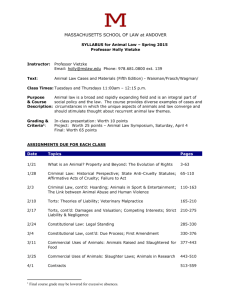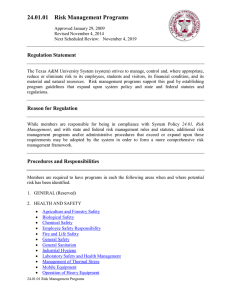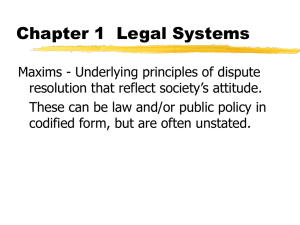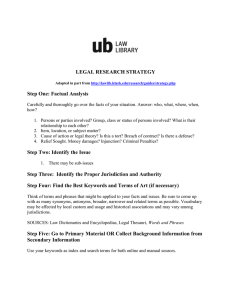CRS Report for Congress Find Them January 16, 2001
advertisement
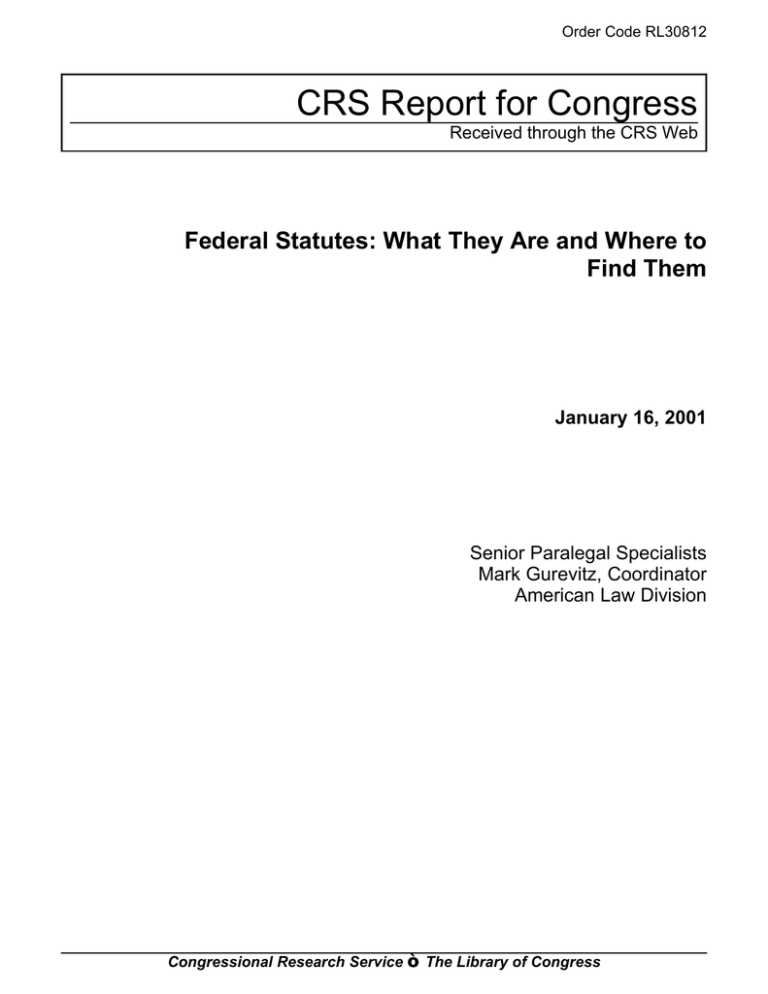
Order Code RL30812 CRS Report for Congress Received through the CRS Web Federal Statutes: What They Are and Where to Find Them January 16, 2001 Senior Paralegal Specialists Mark Gurevitz, Coordinator American Law Division Congressional Research Service ˜ The Library of Congress Federal Statutes: What They Are and Where to Find Them Summary This report provides a brief overview of Federal statutes and where to find them, both in hard copy and on the Internet. When Congress passes a law, it may be amending or repealing earlier enactments or it may be writing on a clean slate. Newly enacted laws are published chronologically, first as separate statutes (in “slip law” form) and, later, cumulatively in a series of volumes known as the Statutes At Large. Statutes are numbered by order of enactment either as Public Laws or, far less frequently, Private Laws, depending on their scope. Additionally, most statutes are also incorporated separately into the United States Code. The United States Code (and its commercial counterparts) takes those Federal statutes that are of a general and permanent nature and arranges them by subject into separate titles. As the statutes that underlay the Code are revised, superceded, or repealed, the provisions of the Code are updated to reflect these changes. Slip law versions of Public Laws are not widely available in hard copy form outside Capitol Hill except at university libraries, law school libraries, or similar depositories (though these often have slip laws in microfiche format only). They are more readily available on the Internet. Statutes At Large is used primarily to research the original language of statutes and laws that are not codified in the Code, appropriations statutes and private laws, for example. The Statutes At Large series often is available at large libraries. The United States Code (and its commercial counterparts) are usually available at local libraries. The Code also is readily available on the Internet, though not always in user-friendly form. Most significant statutes – the Social Security Act, the Elementary and Secondary Education Act, and the Clean Air Act, for example – are published and updated both in a stand alone version, as amended, and as they appear in the Code. Only some, but not all, titles of the Code are the authoritative version of the “law.” For other titles, the authoritative version of the statutes codified therein is the underlying public law, as amended – e.g., the Immigration and Nationality Act of 1952, as amended, is the authoritative version, not title 8 of the Code. After providing an overview on the basics of Federal statutes, this report gives guidance on where Federal statutes, in their various forms, may be located on the Internet, where they are most readily accessible. This report will updated periodically. Contents Public Laws and Private Laws . . . . . . . . . . . . . . . . . . . . . . . . . . . . . . . . . . Alternative Sources of Public Laws (Hardcopy Version) . . . . . . . . . . The United States Statutes At Large . . . . . . . . . . . . . . . . . . . . . . . . . . . . . Public Laws, as Amended . . . . . . . . . . . . . . . . . . . . . . . . . . . . . . . . . . . . . United States Code . . . . . . . . . . . . . . . . . . . . . . . . . . . . . . . . . . . . . . . . . . Annotated Editions of the United States Code . . . . . . . . . . . . . . . . . . Federal Statutes on the Internet . . . . . . . . . . . . . . . . . . . . . . . . . . . . . . . . . Selected sites . . . . . . . . . . . . . . . . . . . . . . . . . . . . . . . . . . . . . . . . . . . 1 1 2 2 3 4 5 5 Federal Statutes: What They Are and Where to Find Them This report provides a brief overview of Federal statutes and where to find them, both in hard copy and on the Internet. When Congress passes a law, it may be amending or repealing earlier enactments or it may be writing on a clean slate. Newly enacted laws are published chronologically, first as separate statutes (in “slip law” form) and, later, cumulatively in a series of volumes known as the Statutes At Large. Additionally, most statutes are also incorporated separately into the United States Code. The United States Code (and its commercial counterparts) takes those Federal statutes that are of a general and permanent nature and arranges them by subject into separate titles. As the statutes that underlay the Code are revised, superceded, or repealed, the provisions of the Code are updated to reflect these changes. Public Laws and Private Laws When a piece of legislation is enacted – that is, when it becomes law under the procedures set forth in Article 1, section 7 of the Constitution – it is characterized as a “public law” or a “private law.” Each new statute is also assigned a number chronologically according to its order of enactment within a particular Congress (e.g., the tenth public law enacted in the 106th Congress was numbered as Public Law 10610; the tenth private law as Private Law 106-10). Private laws are enacted for the benefit of a named individual or entity – e.g., laws in which Congress, due to exceptional individual circumstances, provides an immigration status or government reimbursement to a named person who would not be eligible under generally applicable law. By contrast, public laws are of general applicability. It is the latter category which is of most frequent concern and which forms the basis for the United States Code. Some general laws that are not permanent and continuing in nature, such as appropriations, are not included in the Code and must be researched in the Public Laws/Statutes At Large format. Each new law is first published in pamphlet form (the “slip law” version) by the Government Printing Office (GPO). Individual “slip laws” often are difficult to find outside Capitol Hill, though some libraries may compile them in looseleaf binders or in microfiche collections. Recently enacted laws, especially public laws, are often easier to find in the hardcopy compilations discussed presently, or from Internet resources, as discussed below. Alternative Sources of Public Laws (Hardcopy Version). The United States Code Congressional and Administrative News (U.S.C.C.A.N.) is a commercial service that, among other information, publishes Public Laws chronologically in slip law version. In addition to its annual bound volumes, U.S.C.C.A.N. issues monthly paperbound supplements that include the texts of new enactments and selected portions of the accompanying Senate, House, and/or CRS-2 conference reports. As noted in our discussion of the annotated versions of the Code below, both the United States Code Service and the United States Code Annotated publish new public laws chronologically as supplements. The United States Statutes At Large Slip laws (both public laws and private laws) are accumulated at the end of each session of Congress and published in a series of bound volumes entitled Statutes At Large. These laws are cited by volume and page; e.g., 96 Stat. 1259 refers to page 1259 of volume 96 of Statutes At Large. Researchers are most likely to resort to this publication when they are interested in the original language of a statute or in statutes that are not codified, such as appropriations and other temporary laws or private laws. Public Laws, as Amended Most statutes do not initiate new programs. Rather, most statutes revise, repeal, or add to existing statutes. Consider the following sequence of enactments: ! In 1952, Congress passed the Immigration and Nationality Act of 1952 (Pub. L. 82-414, 66 Stat. 163). This law generally consolidated and amended Federal statutory law on the admission and stay of aliens in the U.S. and how they may become citizens. The Immigration and Nationality Act of 1952 was codified in title 8 of the U.S. Code and comprises almost all of its contents. ! In 1986, Congress passed the Immigration Reform and Control Act of 1986 (Pub. L. 99-603, 100 Stat. 3359). Section 101 of this law, in part, contained provisions that for the first time made it illegal to hire aliens illegally in the U.S. The 1986 Act added these new employer sanctions to the Immigration and Nationality Act of 1952 as a new section 274A. The new employer sanctions, as added to the Immigration and Nationality Act of 1952, were codified in title 8 of the U.S. Code as a new section 1324a (8 U.S.C. § 1324a). ! In 1996, Congress passed the Illegal Immigration Reform and Immigrant Responsibility Act of 1996 (Pub. L. 104-208 (Division C), 110 Stat. 3009). Section 412 of the 1996 Act amended the employer sanctions process an employer must undergo to verify that a new employee is not an illegal alien. As with the 1986 Act, the 1996 Act makes its changes by expressly amending the Immigration and Nationality Act of 1952 – section 274A in this case – with the corresponding section being changed in title 8 of the U.S. Code (section 1324a) noted parenthetically. As the above sequence illustrates, the canvass upon which Congress works is often an updated, stand-alone version of an earlier public law (e.g. the Immigration and Nationality Act of 1952, as amended), and not the U.S. Code. The reason for this is evidenced by the list of the titles of the U.S. Code contained after the title page in each Code volume. An asterisk appears next to some, but not all, of the titles. The asterisks refer to a note that states: “This title has been enacted as law.” In other words, unless a title is asterisked, the authoritative version of the statutory material codified therein – the “positive law” – is represented in the freestanding public laws, as amended. The provisions of the Code in these titles are technically only evidence of the “law.” For example, there is no asterisk beside Title 42 of the U.S. Code in the CRS-3 title list; thus the provisions codified in Title 42 are not authoritative. Rather, the many public laws, as amended, that are codified there are – e.g., the Social Security Act (as amended), the Public Health Service Act (as amended), the Head Start Act (as amended), the Clean Air Act (as amended), etc. The legislative sequence above also indicates that current versions of law represented in the titles without asterisks may be found in one of two places: the codified version in the current U.S. Code and the amended version of the underlying public laws. For instance, current law on employer sanctions, illustrated above, cannot be found in the Immigration and Nationality Act as first enacted (in either slip law or Statutes At Large form) or in any single public law that subsequently amended it. Of the two places where current law may be found in these cases, legal and policy experts most commonly refer to the public law, as amended, version – e.g., the Social Security Act, as amended – and not to the codified counterparts of its provisions. However, it is often difficult to find current, updated versions of frequently amended public laws. Many congressional committees periodically issue committee prints containing the major public laws within their respective jurisdictions. However, the frequency of these prints varies and they are often difficult to obtain. Alternatively, various commercial publishers print updated versions of major public laws. Also, the amended versions of major public laws can sometimes be found via the Internet, as is discussed further below. United States Code The first edition of the United States Code [U.S.C.] appeared in 1926. It is now published every 6 years and supplemented during the intervals by annual cumulative bound volumes. The latest edition is the 1994 edition. The U.S.C. is printed by the United States Government Printing Office. Those statutes that are included in the Code are grouped by subject into fifty titles. Each title is further organized into chapters, sections and subsections, again by subject matter. The Code is cited by title and section, e.g., 28 U.S.C. Sec. (Or §) 534 refers to section 534 of Title 28 of the United States Code. Each volume of the U.S.C. contains a listing of its titles, whose names provide general guidance as to their contents. For example, Title 7 deals with agriculture, and Title 45 with railroads. However, this is only general guidance, since legislation on broad topics is frequently scattered throughout several titles of the Code. Notes at the end of each section provide additional information, including statutory origin of the code provision (both by public law number and Statutes At Large citation), the effective date(s), a brief citation and discussion of any amendments, and cross references to related provisions. CRS-4 Annotated Editions of the United States Code. The United States Code Annotated (U.S.C.A.) and the United States Code Service (U.S.C.S.) are unofficial, privately published editions of the United States Code, published by West Publishing Company and Lawyer’s Co-operative Publishing Company, respectively. The major additional features of these publications include annotations to judicial decisions interpreting the Code sections and references to pertinent sections in the Code of Federal Regulations (C.F.R.). The main distinction is that the U.S.C.A. purports to include all annotations, so that a single volume may encompass only two or three Code sections, while the U.S.C.S. provides more selective but more detailed annotations, and also includes references to some law review articles. Bound volumes of the U.S.C.A. and the U.S.C.S. are brought up to date through use of annual inserts, known as “pocket parts,” and more frequent paperbound supplements. These updates include newly codified laws and new annotations. Both U.S.C.A. and U.S.C.S. also issue pamphlets containing copies of recently enacted laws arranged in chronological order. Since there is frequently a time lag in publishing the United States Code, codified versions of new enactments usually appear first in U.S.C.A. and U.S.C.S. supplements. Additionally, versions of the finding aids discussed below are also available in the U.S.C.A. and U.S.C.S. General Subject Index. Each edition of the United States Code has a comprehensive subject matter index, under which it is possible to research laws by subject matter. Assuming one wished to locate the provision of law establishing a review committee for farm marketing quotas. Using the index under the term “farm marketing quotas,” one is referred to several other subject headings, including the Agricultural Adjustment Assistance Act of 1938. Turning to that heading and looking under the subheading “farm marketing quotas,” there is a reference to a “committee for review” codified at 7 U.S.C. § 1363. Popular Name Table. Each edition of the Code also has a Popular Name Table, “Acts Cited by Popular Name,” through which it is possible to obtain information (Public Law number, location in the Statutes At Large, location in the United States Code) on laws by checking the names by which they are commonly known. If the original laws have been amended, the same information is provided for each amendment. To illustrate, assume we are interested in locating the “Special Drawing Rights Act” in the United States Code. Looking at the Popular Names Table, we find that it has been codified at 22 U.S.C. § 286q. Statutes at Large Table. By showing the relationship between public laws, the Statutes At Large, and the United States Code, the Statutes at Large table for the Code is one of the most useful statutory research tools. Thus a researcher who has either a public law number or a Statutes at Large citation can use this table to ascertain where that law is or was codified, as well as its present status. It is particularly useful when the researcher is interested in one section of a law that contains many sections, since it is possible to use this table to find where CRS-5 individual sections of a public law have been codified. For purposes of illustration suppose that we were interested in finding where § 1403 of Public law No. 99-661 has been placed in the U.S. Code. Through the Statutes At Large table, we can determine that it can be found at 20 U.S.C. § 4702. Federal Statutes on the Internet The Internet has made legal resources, including Federal statutes, more widely available to both scholars and the general public. Still, one must use care in obtaining Internet materials: ! Materials on Internet sites may not be up-to-date, and it may be difficult to discern how current the material is or whether it has been revised. ! However extensive Internet materials may be, it still may be difficult to find current federal statutes, especially in the case of “popular name” statutes that are amended frequently. Not all Federal agencies include current versions of the statutes they administer on their websites. At the same time, many agencies that do not include the full text of the statutes that govern their programs do provide useful summaries and discussions of them. ! As is the case with other Internet materials, the inclusiveness and location of statutory materials on a given website may change frequently. Also, websites clearly vary in the ease of finding materials through them. Selected sites. With the foregoing caveats in mind, we include the sites below as possible public sources for the selected statutory materials noted. The absence of a particular statute on the list does not imply that it is unavailable electronically. Nor does the inclusion of a site guarantee its continuing location or currency. Public laws: Thomas Public Laws [http://thomas.loc.gov/bss/d106/d106laws.html] GPO Public Laws [http://www.access.gpo.gov/nara/publaw/106publ.html] U.S.C.: Office of Law Revision Counsel U.S.C. page [http://uscode.house.gov/uscode.htm] Cornell Law School U.S.C. page http://www4.law.cornell.edu/uscode/] GPO U.S.C. [http://www.access.gpo.gov/congress/cong013.html] Popular Name: General: Cornell Law School Popular Name Index [http://www4.law.cornell.edu/uscode/topn/] CRS-6 Chronological list of laws and regulations regarding Reclamation Activities [http://www.usbr.gov/laws/chronol.html] FedLaw - Federal Laws and Regulations [http://www.legal.gsa.gov/intro2.htm] Selected specific statutes: Abandoned Shipwreck Act of 1987 [http://www2.cr.nps.gov/laws/ship.htm] American Antiquities Act of 1906 [http://www.cr.nps.gov/local-law/anti1906.htm] American Indian Religious Freedom Act of 1978 [http://www2.cr.nps.gov/laws/religious.htm] Americans with Disabilities Act [http://www.usdoj.gov/crt/ada/pubs/ada.txt] Archaeological and Historic Preservation Act of 1974 [http://www2.cr.nps.gov/laws/archpreserv.htm] Archaeological Protection Act of 1979 [http://www2.cr.nps.gov/laws/archprotect.htm] Antiquities Act of 1906 [http://www4.law.cornell.edu/uscode/16/431.html] Bankruptcy Code [http://www.alltheweb.com/go/01/H/www.law.cornell.edu/uscode/11/] Civil Rights Act of 1964, Title 7 [http://www.eeoc.gov/laws/vii.html] Clean Air Act [http://www.epa.gov/oar/caa/contents.html] Clean Water Act (CWA) [http://www4.law.cornell.edu/uscode/33/ch26.html] CERCLA or Superfund Act [http://www4.law.cornell.edu/uscode/42/ch116.html] Clayton Act [http://www.usdoj.gov/atr/foia/divisionmanual/ch2.htm#a1] [http://www.law.cornell.edu/uscode/15/12.shtml] Controlled Substances Act [http://www.deadiversion.usdoj.gov/21cfr/21usc/index.html] CRS-7 Davis-Bacon Act [http://www.dol.gov/dol/esa/public/regs/statutes/whd/dbra.htm] Endangered Species Act (ESA) [http://www4.law.cornell.edu/uscode/16/ch35.html] Energy Policy and Conservation Act [http://www.law.cornell.edu:80/uscode/42/ch77.html] Equal Access to Justice Act [http://www.law.cornell.edu/uscode/5/504.html] Fair Labor Standards Act (FLSA) and Amendments [http://www.dol.gov/dol/esa/public/regs/statutes/whd/allfair.htm] Fair Packaging and Labeling Act [http://www.law.cornell.edu/uscode/15/ch39.html] Family and Medical Leave Act (FMLA) [http://www.dol.gov/dol/esa/public/regs/statutes/whd/fmla.htm] Federal Communications Act 1934 [http://www.fcc.gov/Reports/1934new.pdf] Federal Food, Drug, and Cosmetic Act (FFDCA) [http://www4.law.cornell.edu/uscode/21/ch9.html] Federal Insecticide, Fungicide and Rodenticide Act(FIFRA) [http://www4.law.cornell.edu/uscode/21/ch9.html] Federal Trade Commission Act [http://www.law.cornell.edu:80/uscode/15/41.shtml] Freedom of Information Act [http://www.nara.gov/fedreg/legal/apa/552.html] Historic Sites Act of 1935 [http://www.cr.nps.gov/local-law/hsact35.htm] Immigration and Nationality Act [http://www.ins.usdoj.gov/graphics/lawsregs/INA.htm] CRS-8 Individuals with Disabilities Education Act [http://www.ed.gov/offices/OSERS/IDEA/the_law.html] Intermodal Surface Transportation Efficiency Act of 1991 [http://www.bts.gov/smart/cat/istea.html] Job Training Partnership Act [http://www.doleta.gov/regs/statutes/jtpalaw.asp] Labor-Management Reporting and Disclosure Act [http://www.dol.gov/dol/esa/public/regs/statutes/olms/lmrda.htm] Lanham Trademark Act [http://www.law.cornell.edu:80/uscode/15/ch22.html] Longshore and Harbor Workers' Compensation Act [http://www.oalj.dol.gov/public/lgshore/refrnc/lhwca.htm] National Environmental Policy Act of 1969 (NEPA) [http://es.epa.gov/oeca/ofa/nepa.html] National Labor Relations Act [http://www.nlrb.gov/publicat.html] National Park Service Organic Act [http://www.nps.gov/legacy/organic-act.htm] Occupational Safety and Health Act (OSHA) [http://www.nps.gov/legacy/organic-act.htm] Oil Pollution Act of 1990 (OPA) [http://www4.law.cornell.edu/uscode/33/ch40.html] Pollution Prevention Act (PPA) [http://www.epa.gov/opptintr/p2home/uscode.htm] Rehabilitation Act Amendments of 1973 [http://www.access-board.gov/enforcement/rehabact-text.htm] Resource Conservation and Recovery Act (RCRA) [http://www.epa.gov/opptintr/p2home/uscode.htm] Safe Drinking Water Act (SDWA) [http://www4.law.cornell.edu/uscode/42/300f.html] Securities Act of 1933 [http://www.law.uc.edu/CCL/33Act/index.html] Securities and Exchange Act of 1934 [http://www.law.uc.edu/CCL/34Act/index.html] CRS-9 Sherman Antitrust Act [http://www.usdoj.gov/atr/foia/divisionmanual/ch2.htm#a1] Small Business Act [http://www.sbaonline.sba.gov/regulations/sbaact/sbactdec99.html] Small Business Investment Act of 1958 [http://www.sbaonline.sba.gov/INV/act/sbicactaug99.html] Small Business Regulatory Enforcement Fairness Act of 1996 [http://www.sbaonline.sba.gov/regfair/regfairreg.html] Social Security Act [http://www.ssa.gov/OP_Home/ssact/comp-toc.htm] Toxic Substances Control Act (TSCA) [http://www.ssa.gov/OP_Home/ssact/comp-toc.htm] War Powers Resolution [http://www.law.cornell.edu/uscode/50/1541.html]

